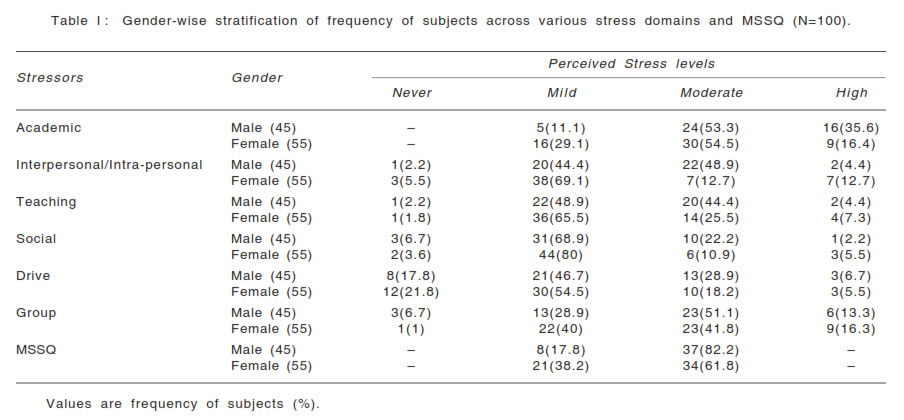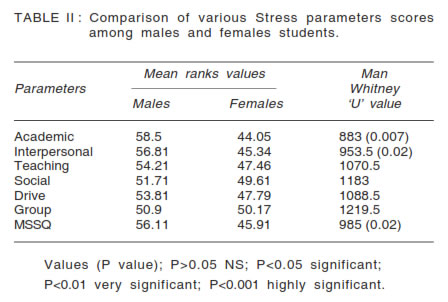and Pharmacology
Indian Journal of Physiology and Pharmacology |
 (252x320).jpg) |
Volume 58 - Number 2 April - 2014 (Current issue) ISSN 0019-5499 |
Gender Correlation of Stress Levels and Sources of Stress Among
|
Medical courses in India are very demanding for the students thus making career in medical education very stressful. The study was designed to determine the prevalence of stress levels in 100 first year medical students and to explore the sources of stress & it‘s relationship across the male and female students. Demographic information and Qualitative data from investigator tailored Medical Student Stress Questionnaire (MSSQ) by self rating under supervision of investigators were subjected to a thematic analysis. Stress perceived was more in males students (82.2%) as compared to females (61.8%) and their MSSQ index score was significantly different (U=985; P=0.02). Moderate to high academic stress was present among 79% of students more so in males with the academic domain score significantly different from that of females (U=883; P=0.007). Females perceived more stress in inter personal domain (12.7%) with the score significantly different from males (U=953.5; P=0.02). Group and Teaching stress was equally present in males and females. |
Medical courses in India are very demanding for students which involves emotional aspect as well, sometimes making career in medical education very stressful (1). Studies have proved that compared to general population medical students are more stressed of the students (2) and has led to suicide and suicidal attempts by them (3). The stress stems from fear of failure, academic pressure, perfectionist standards, enormous content that has to be mastered in small time frame, higher expectation from parents & peers, and exhaustive work schedules in addition to the frequent assessment and examination (4) & compulsion for educational program that may not be their first choice (5). Stress has been shown to manifest somatic, visceral & emotional symptoms which negatively affect their academic performance (6). Elevated corticosteroid levels during stress can impair declarative memory, concentration, and learning (7). Studies from developing countries like Nepal,
Pakistan, Thailand, Malaysia and India have reported stress among medical students and have underscored
role of academics as a potential stressor (8, 9, 10,
11, 4), but did not addressed them across males
and females students. Since the perception of stress
is frequently influenced by socio-cultural factors,
gender and ethnicity and educational systems (12),
the results of studies in one region cannot necessarily
be generalized to the others. In view of these the
study was taken to determine the prevalence of stress
in first year medical students of Himalayan institute
of medical sciences and to explore sources of stress
and it's relationship across male and female students. |
The study was conducted at department of Physiology HIMS, HIHT University. After getting clearance from ethics committee of the university first year MBBS students (n=100) of HIMS were invited to participate in the study. Following informed and written consent the volunteers were asked to self-rate the tailored Medical Student Stress Questionnaire. Data collection was done in February in middle of academic term. To investigate the sources of stress the questionnaire was tailored from the Medical student stress Questionnaire (MSSQ) (13) which consisted of a set of 40 questions on several domains of stress perceived by them. All the 40 questions had 5 responses on Liker scale and the sum of responses of domain were normalized and scaled asmild (0-1), moderate (1.01-2); high (2.01-3) & severe (3.01-4). The questions were addressed to six domains of stress which included, Academic related: involving examination, learning context, competition, falling behind in schedule etc; Intrapersonal & interpersonal: verbal/physical abuse, conflicts with peers and teachers, health problems etc; teaching related: inadequate study material, lack of guidance, teaching skills, feedback from teachers etc; Social related: interruption by peers, lack of time for friends and families; Drive related: parental wish, unwillingness; Group activities related: peer pressure, performance and discussion. Demographic information (age, genderetic) was obtained within the same questionnaire. Identities of the volunteers were kept hidden by randomly allocating IDs to recruiting volunteers. They were allowed to fill the questionnaire, seal the envelops and drop it in a drop box. Statistics Data was analyzed by SPSS ver17. Descriptive analysis of levels of stress in all six domains were stratified by gender and presented as frequency& percentages of subjects having that level of stress. Mann Whitney "U" test of significance was used to see the difference between the genders with respect to levels of stress across all domains with levels of significance set at 0.05. |
None of the students experienced severe level stress in any of the domain. Academic stress was moderate to high in 79% of the students more so in males (35.6%) as compared to females (16.4%). Several of them reported increased work load due to huge course content squeezed in less than 1 year as most important of the cause. Moderate to high Inter personal and intrapersonal stress was reported in 40% of the students with females showing high stress (12.7%) due to inter personal relationship as compared to males (4.4%). 40% of students had Moderate to high Teaching stress because of the examinations, seminars and tutorials with almost equal in proportion among males & females (48.4% vs 32.7%). Social factors were causing moderate stress in 22.2% of males as compared to 10.9% in females. 20% of students never felt lack of drive because of stress. Moderate to high Group stress was almost equally seen in males and female students. 82.2% of the males and 61.8% of the females were having moderate type of overall stress during the first year of the MBBS at HIMS College (Table I). Statistically significant difference between males and females was observed in academic (U value 883; P=0.007) and in MSSQ index score (U value 985; P=0.02) with males more affected than females, whereas interpersonal stress was more in females (U value 953.5; P=0.02). Significant association of academic, interpersonal and MSSQ index was seen with gender, with the females exhibiting less stress levels as compared to males (Table II). |
 |
 |
Tertiary education has always been regarded as highly stressful environment to student. Studies have revealed a high prevalence of stress in medical students, ranging from 30% to 50% (14, 4). The overall prevalence of moderate to high stress in our study is (71%) which is higher to Thai study (61.4%) (10), a Malaysian study (41.9%) (11) and a British study (31.2%) (14). This difference could be either due to the different instruments used in other studies or it could be a real difference. Our study showed that 25% students reported high stress levels related to the academic that included frequent examinations & assessment methods, grading methods, academic schedule and lack of time for review. The same was observed as the greatest source of stress in Malaysian study (24%) (11), by Chandra sheker et al (8) in Indian students at a medical college at Nepal and in studies at Saudi Arabia (25%) (15). More than 50% of medical students at Pakistan medical college reported academic stress in higher quartile (Mean >28) in the study by Shah et al (9). Study of Abraham et al on Indian first year students of MMC also observed a higher % of students (52.5% to 91.2%) having sources of stress from academic category regarding information overload and frequency of summative examination (16). Stress associated with examinations was reported across all the years of BDS by Acharya (17) but not observed by Westerman et al (18). Supe A N in his study found that 73% of first year medical students perceived stress with academic factors as a greater perceived cause of stress in MBBS medical students (4). First year students in India have to undertake repetitive summative examination of the three subjects. With 8 hrs of teaching in a day they hardly have spare time for de-stressing. Only 9% of the students faced high stress due to relationships within one's own self, including poor motivation to study, health problems and self-conflict which was more in females severe health related stress was observed by Hamza et al (15) in Saudi students (7.2%) mostly in females. Difficulty with the colleagues and problems with roommate, and difficulty in approaching the teachers varied from 11.6 to 25.8% among first year students by Abraham R et al (16) and was higher in students at Nepal (36.2%) (8). Moderate to high Stress due to teaching was observed in 40% of students almost in equal proportion of male & female students. Lesser percentages were observed by Abraham et al in MMMC medical students (< 12.5%) (16). Lesser stress associated with faculty behavior among first year students of dental college was also seen by Acharya S (17). The finding are in contrast to those reported by Westerman et al where the nonclinical years were more stressful however the study was done in dental students & can be because of limited interaction with first year students (18). Moderate to high level of Social stress was seen in 20% of the students at our study butless social stress was also observed by Shah et al (9). Psycho-social stress was same in Indian students studying in Nepal (21.7%) (8) but higher in Malaysian students (41.9%) (11) which may be due to different tool used for analysis of stress. In our study Social stress was more in males than in females which can be due to inquisitive nature of males and the liberty taken by them away from home. Also since no patients’ interaction is there in first year, such stress is not evident in first year of MBBS. Moderate to high stress due to Unwillingness to study or study by compulsion was evident in both females and males (13-16%). Parental compulsion was observed to be 60% responsible cause of stress in study by Shah et al (9). Similar results were also seen by Acharya (17) but in dental students. Unwillingness and dissatisfaction of joining the course that is not their first choice causes reduced tolerance to behaviour of faculty. Only 15% of the students had high to severe stress because of participation and discussion in class, and feeling of incompetence. Similar finding was observed Shah et al (9) among medical students and by Acharya (17) in students of dental college with facing parents after failure was most stressful item. Pressure for the future and first exposure to an entirely different system of education develops fear & competition which reflects as stress in participation, group discussions & presentations. Over all stress by MSSQ score was more in male students (82.2%) as compared to females (61.8%). Females seem to cope better to the stress as compared to the males as they have good social support and they inherit faster sex processing speed for timed intelligence tests than males (19). These finding are in disagreement to some other studies which showed female to suffer from higher stress than males (20, 9, 15). Our study have shown gender significant differences in only academic and inter-personal stress domains & mean MSSQ scores of stress was significant factor in reporting of stress in medical students. Limitations This cross-sectional study was based on self-reported Information provided by students, therefore the limitations are :
Conclusion The study perceived the factors affecting stress among first year medical students with 71% of the students face moderate to high levels of stress in our medical college. |
Authors are thankful to the Himalayan Institute of Medical Sciences, HIHT University, for providing support services, infra structures and finance for the study. |
|